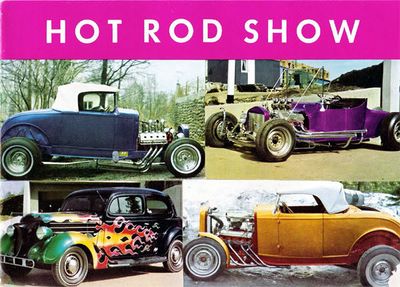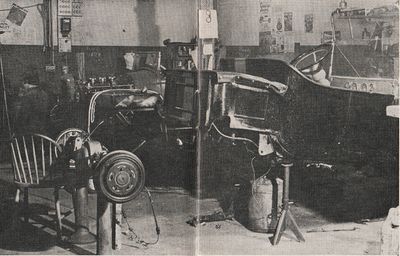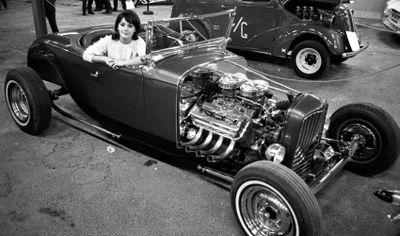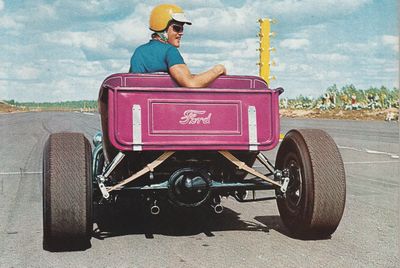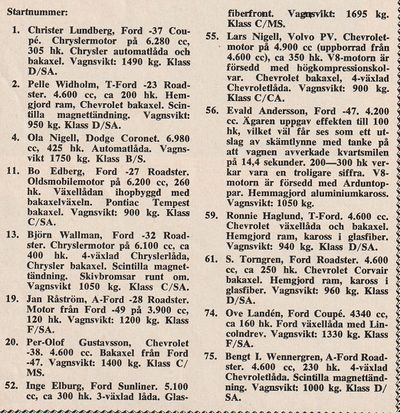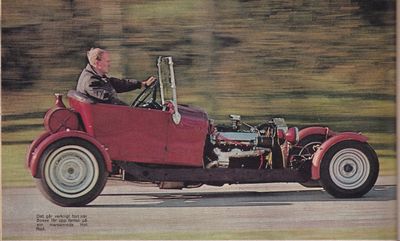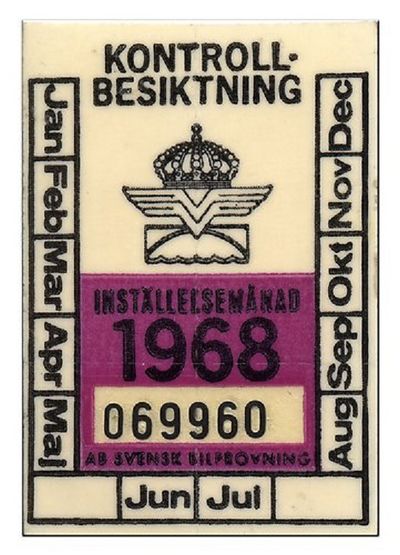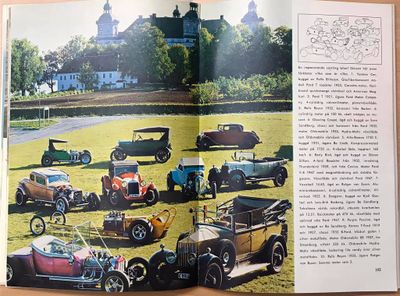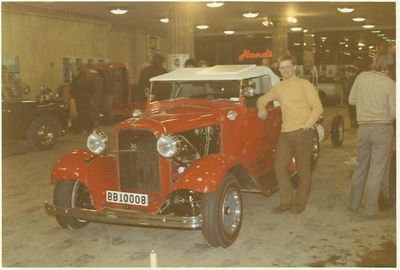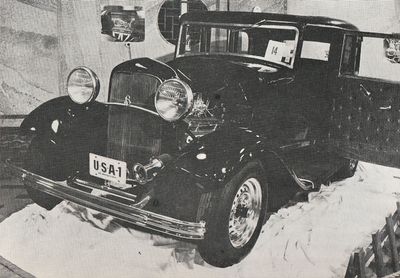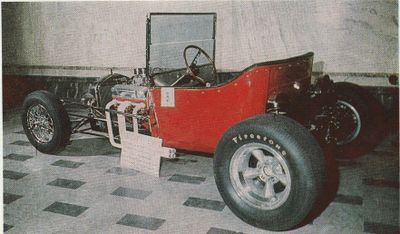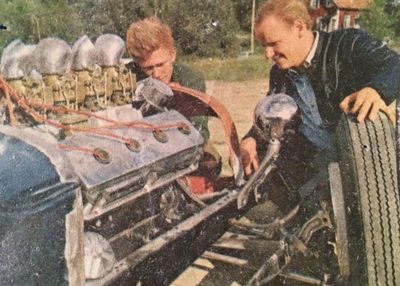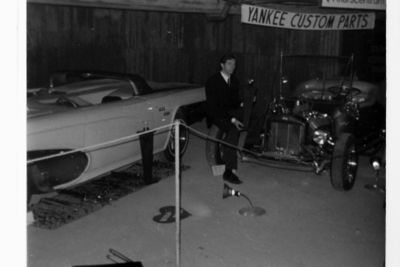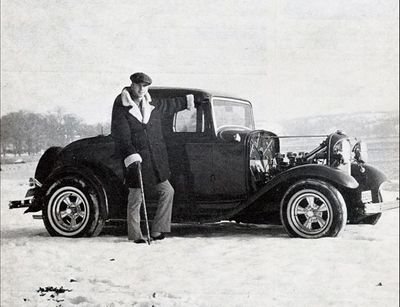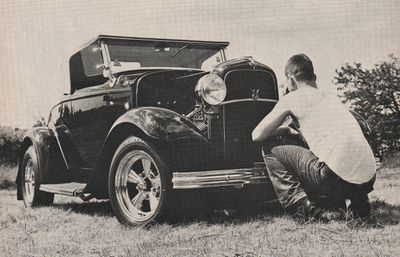Swedish Hot Rod history (between 1965-1970)
Contents
- 1 Swedish Hot Rod History 1965 - 1970 (part 3)
- 1.1 The Show must go on
- 1.2 START & SPEED magazine
- 1.3 New authorities makes it harder to modify your vehicle
- 1.4 Free speed applied outside populated areas
- 1.5 The authorities get involved. Inspection, TSV and crash test!
- 1.6 Yet - cars were modified and Hot rodded more than ever by new generations
- 1.7 Hot Rods and Dragracing
- 1.8 Tough times, but don't give up!
Swedish Hot Rod History 1965 - 1970 (part 3)
As described in part 2 of this series, a major development of car construction took place in Sweden during the first half of the 1960s.
Different gangs were formed, new friends with the same interest were found, mostly in larger cities.
They helped each other find renovation objects, look for scrap metal and different types of jobs such as welding, tuning and painting. (Picture 2) (Picture 15)
On the countryside, many skilled "lone-wolfs" began to build Hot rods and Customs, finding most of the parts at local yunk-yards.
Unfortunately, new governmental authorities was founded, setting sharp regulations on car modifications.
If you will have to summarize this period 1965–1970, from the perspective of a then active Swedish Hot rodder, it must have been a bit of an emotional roller coaster with both hope and despair!
The Show must go on
When the first public exhibitions (Hot Rod Show) popped up Stockholm in 1964–1965, the interest increased even more.
The number of visitors grew every year and newspapers drew attention to the phenomenon with the fantastic rebuilt vehicles. (Pictures 1, 13, 14)
The organizers Bosse "Gamen" Sandberg, Jonas Qvarnström, Acke Nordström and others, tried to gather as many cars as possible to the shows.
Some did not have time to be fully finished but were shown anyway. (Picture 3, 4)
In 1966, an attempt was made to get Ed "Big daddy" Roth and some of his vehicles to Sweden.
"Gamens" new partners Matti Johansson and Lenta Möllberg traveled to Los Angeles for a discussion.
Unfortunately, Roth made unreasonable financial demands on travel, accommodation and transportation for the vehicles back and forth. And $ 10,000 in compensation!
Instead, the boys brought home custom-made T-shirts with prints for the show in 1967, unfortunately not a success, only a few shirts were sold.
Sweden was probably not mature for this product. The remaining part went to Gunnar Olsson's company Roach. It would be fun if any of these T-shirts are preserved in a wardrobe somewhere!
Tours were also arranged with the cars in various places in Sweden.
Called "Hot Rod Festival" and was in Gothenburg, Linköping, Örebro and several places (Picture 8) between 1966 and 1969. (Picture 17)
The exhibitions in Marmorhallarna between 1965 and 1976 today have a strong cult status with their special atmosphere.
Many of us remember the smell of popcorn, rock music, the movie corner with Dragracing movies from the USA and all the cool vehicles. "An orgy in chrome and color".
If you participated yourself or knew someone, you could enter on the moving-in evening and mingle with like-minded people! Award ceremony were always Friday night.
As far as we know, no major outdoor meetings were arranged during the summer, but they hung out with local car enthusiasts.
Later, the Dragracing competitions events became national gathering points for Hot rods and in the 70's various rod meetings were arranged around Mälardalen.
Interest also spread strongly outside Stockholm. There were many old cars standing in barns that became the subject of Hot Rodding. Handy good guys welded up bodies and found suitable engines, axles and more at the nearest scrap yard. Then you could order accessories by mail order from the companies that imported from the USA.
Many contacts were established with the United States. The exclusive club "Los Angeles Roadster Club" had two members in Sweden who could ride with their signs. It was Bosse "Gamen" Sandberg and Stig Brohlin.
Some of the companies formed at this time;
- - “Kasby Motor”, Älvsjö, Stockholm. Bo and Ove Kasby. (Picture 21)
- - "Yankee Custom Parts", Örby, Stockholm. "Gamen" and more.
- - "Rogers Custom", Gothenburg.
- - "Hansen Racing", Stockholm. Carl Hansen with family.
- - "California Racing", Stockholm. (Bought later by Hansen).
- - "Americano Enterprises", Linköping.
- - "Hot Rod Center", Jordbro. Sixten Persson.
- - "Ronwill Speedshop", Nytorget, Stockholm. Ronald 'Rolle' Blom.
- - American Auto-Accessories. Orsa, Gunnar Olsson (Roach).
START & SPEED magazine
At the end of 1965, Start & Speed, "Motorentusiastens magazine", was started by Bengt Björklund and Chris Wollin in Lerum and the enthusiasts finally
got a magazine that (somewhat) matched the area of rebuilt US cars and drag racing. (Pic #18)
It was written in the first issue:
- "We think of you who like everything new that moves - HOT RODS - CUSTOM CARS - and BIKES - DRAGSTERS."
However, the magazine's content was initially very broad with elements of, among other things, Go-cart, Hillclimb and Slotracing (car track).
Some young writers and photographers who can be mentioned were Kjell Gustafsson (then living in the USA), Åke Wremp and Arne Pontán. Kjelle started his own magazine "Power magazine" in 1976.
It is unknown how the magazine was received by the die-hard threat rodders who were in the country, but they mainly helped to push a lot for Dragracing in Sweden.
The magazine's content also became more refined over time in line with readers' interests.
A couple of articles about Hot rods, Customs and Choppers in each issue as well as a good place for advertising for the accessory companies that existed. We got our "own" Swedish newspaper!
Towards the end of the 60's, however, the trend towards Dragracing is more noticeable.
That was one reason why Bosse "Gamen" started the magazine Colorod in 1970, when he felt that Choppers, Customs and Hot Rods got too little space in the existing media.
More (color) images and less text became his new format!
New authorities makes it harder to modify your vehicle
Of course, the cars drew attention to both good and bad.
At that time, there were no clear authorities or rule book to consider, it was usually the local police who would assess the vehicles' equipment
and safety and whether it was driven in a dangerous manner. Many lost their "drivers license" for a while but then came back!
Sometimes the cars could change identity by changing signs, some went on trips abroad where it was more difficult to control the cars.
Free speed applied outside populated areas
In Sweden, there had been general speed limits since 1907. In urban areas, it was then allowed to drive a maximum of 15 kilometers per hour during the day,
10 km/h after the sun had set.
After 15 years, the limit was raised: It was allowed to drive 35 kilometers per hour in populated communities! For roads outside, a maximum limit of 45 kilometers per hour
was introduced. But often the roads were simply so bad that it was not possible to reach that speed!
In 1930, the speed limits were completely abolished. Instead, the Royal Road and the National Board of Water Construction, the forerunner of the Swedish Road Administration,
introduced the rule that drivers should not drive faster than they could stop within the stretch of road they saw!
With the increase in motoring, these rules became unsustainable. In the 1950s, the stated maximum speeds for urban areas were reintroduced; 50 kilometers per hour. However, the many accidents in the traffic of that time made it necessary to have temporary speed limits such as max 80 km/h on major weekends such as Easter.
The sign "speed limit end" was removed permanently in most places in connection with the change to right-hand traffic in 1967.
It formally disappeared in January 1970. But only a year later it was decided on a maximum speed limit, which could be allowed on highways: 130 kilometers per hour.
Two years later, that limit was lowered to 110.
The authorities get involved. Inspection, TSV and crash test!
In 1966, one year before the right-wing change, mandatory periodic car inspections were introduced in Sweden. This was of course a hard blow for Hot rod and custom builders as the car's equipment and condition would match the registration certificate. Frame numbers and identities were carefully checked and it was difficult to "get away".
However, some succeeded in having their modifications previously entered in the instrument (such as "engine replaced", "body modified", etc.), and were thus able to get the car legal even during inspection. There were often many and long discussions at a registration inspection before the authorities could accept the vehicle.
The control mark (Fig. 10) also called "Owl" to paste on the box was introduced in connection with the inspection. This was abolished in 1974 and replaced with a tax receipt on the (newer) registration plate which showed that the vehicle had been taxed and inspected.
Above all, the Hot rod riders had not had the best relationship with the police for a long time, mostly because the "driving of the vehicle" was not the most appropriate. It was difficult to accept the bureaucracy as it was considered that safety had actually been improved with hydraulic brakes, reinforced frames and modern wheel suspensions. As well as increased reliability with newer engines and transmission.
Now they were faced with a choice when building a "new" car with different parts from the scrap or with a homemade frame / construction: - Should I try to have the car inspected? or - Should I build a car to exhibit at the Hot Rod Show?
The authorities saw that the number of fatal accidents dropped drastically thanks to vehicle inspections. In 1968, TSV (Swedish Transport Safety Agency) was also formed with the aim of continuing to work for regulations and regulations regarding vehicles. The mills of the bureaucracy grinded with officials who barely knew anything about technology and mechanics. Other traffic organizations such as the "National Association for the Promotion of Road Safety", NTF were formed as early as 1934 and ran the Zero Vision for traffic fatalities. (NTF was declared bankrupt in April 2022).
In 1969, a bill was submitted to the government on sharp restrictions on the rebuilding of cars and that new cars must undergo a destructive (approved) crash test in order to be sold and used in the country. Unfortunately, there were well-known engine profiles such as the radio presenter CG Hammarlund (NTF) and others in the crowd who disliked other than "factory standard".
The new regulations were approved and came into force on 1 July 1970. This of course became completely devastating for the amateur builders who in principle had to build two identical vehicles, one of which was destroyed! MC (chopper) was also affected as in principle no extension of the fork was allowed.
There were many who were in a hurry to get their car approved before that date! It is said that Peder Landberg with his T-bucket was the last who managed to be approved! (Pic #20)
Yet - cars were modified and Hot rodded more than ever by new generations
The enormous interest that existed among young people in the country could not be stopped. Rods and custom cars were built like never before!
It was easy to get hold of items and parts at reasonable prices. A feverish activity was going on in the garages to get the car approved and avoid the new crash tests!
(Picture 9, 11, 12, 13, 14, 19, 20)
A rough compilation on Kustomrama.com shows a list of over 40 Hot rods that were built during the period! There were probably many more that we do not know.
The Hot Rods that were in Sweden at this time were used a lot and were driven hard. It was often the young boys' only car that was rebuilt and costly with limited finances.
Over the years, the wildest ones began to settle down and calm down a bit. Some invested in boats (you got to be more at peace on the lake), others invested in Dragracing.
A list of selections of Hot rods built between 1965 and 1970, with a short history ;
- Bengt Wennergren's 1931 Ford Model A Roadster. Changed owner and appearance several times, now in the US.
- Jonny Burger's 1931 Ford Roadster. Probably exported to the USA in the 70's.
- Janne Råström's 1928 Ford. Restored and rolling since the 80's in Linköping
- Pelle Widholm's T-23 bucket. Bought by Calle Weman, in the USA for many years, is today in Örebro.
- Björn Hagelfors' 1932 Ford 5-Window Coupe. Sold to the USA in the 1960s.
- Jan 'Benjamin' Wahlström's 1932 Ford 5-win Coupe. Sold to England in the early 1970s now owned by Keith Abrehart
- Stig Dahlin's T-23 Yankee Car. Rebuilt and managed to be inspected in Åtvidaberg in 1979. Crashed fatally the same year. The remains are preserved.
- Ture Lindholm 1934 Ford Tudor. Remains with a new owner in Linköping.
- Ivve Hallberg's 1932 Ford Cabriolet. Remains in the same condition in Floda, Västergötland.
- Benke Björkman 1932 Ford Cabriolet. Sold by Benke in 2016 to a new owner in Sweden.
- Staffan Runhags 1947 Ford Pickup. Unknown destiny.
- Janne Serrander's 1932 Ford 3-Window Coupe. Has gone through many owners but is now managed by Tommy Andersson in Huddinge.
- Lars Larre Andersson 1938 Ford Convertible. Standing on Larre's lot in Sundbyberg for 30 years! Now sold to Bålsta.
- Thomas Kaakinen 1931 Ford Roadster. Unknown destiny.
- Bosse Edberg T-23 Hot Rod. Bosse still has the rod at home in Danderyd!
- Sture Torngren's T-23 Ford. Sold in 2001, now in Sigtuna and used extensively! Looks the same.
- Peder Landberg T-23 Ford Pickup. Peder still has the rod!
- Tommy Andersson 1939 Chevy Coupe. Still in Tommy's possession.
- Stig Sinclair 1939 Ford Convertible. Still in Stickan's possession.
- Bill Palmgren's 1940 Ford Coupe. Still in Bill's possession.
- Staffan Runhag 1936 Ford 3-Window Coupe . Has been worn down by many different owners. Is now back in Enköping for a new version!
- Kent Larssons 1932 Ford 3w Coupe. Still owned by Kent in Västerås.
- Per Iggstens 1937 Ford Convertible. Sold to the United States in the 1970s.
- Per Johansson's 1939 Ford 4-door sedan. Unknown destiny for this car.
- Hasse Zetterqvist / Greg Ekholms 1937 Ford. Gregge sold the car in 1988. The current owner is in Flyinge, Skåne.
- Sven Sandbergs 1937 Ford Coupe - Mystic Blue. Had several owners after Svenne, still well maintained.
- Tony Jönsson's 1933 Plymouth Coupe. Started as a Dragrace car together with Anders Lantz. The car is now inspected and is still owned by Tony.
- Jan Adolfsson's 1936 Ford 3-win Coupe. Still in Janne's possession in Närke.
- Leif Hedén's 1932 Dodge Coupe. Still in Leif's possession and looks the same.
- Lars Skogbergs 1932 Ford 5-Window Coupe. Lars sold the car in 1994, it still rolls on hits around Värmland.
- Sverker Ekström's 1939 Ford std coupe. Sold in 1993 to Håkan Pettersson in Örebro.
- Bengt Aronsson's Ford 1946 coupe. Sold by Bengt in 1985 to Jan Ullman, since 2001 new owner in Umeå.
- Anders Reinlis 1939 Chevrolet - Princes. Not sure if the car was street registered, it has been in a garage in Denmark for many years.
Hot Rods and Dragracing
Bengt Wennergren had already in 1966 taken his 1931 Ford Roadster to Ramstein in Germany and driven Dragracing at the American military base there.
Bengt got a bleeding tooth and the club "Swedish Drag Racing Club" was formed in Stockholm the same year. A total of 34 members with many famous names:
Torsten Fritz, Tage Hammerman, Jonas Qvarnström, Sven Sandberg, Bo ”Gamen” Sandberg fa. Yankee car, Lars ”Junken” Ljungqvist, Krille Lundberg, Janne ”Benet” Wahlström,
Olle Bergström, Kalle Bengtsson (Falcon Sprint), Matti Johansson, Lars Malmberg, Hasse Radefalk and others.
In the autumn of 1966, the first Dragracing competition in Sweden was run on a piece of unopened motorway between Stockholm and Enköping.
Several rodders and Bosse "Gamen" Sandberg participated here with a dragster that was originally built by "Sillarna". (Picture 16)
Bengt and some other boys went over to the USA in the beginning of 1967, got in touch with the NHRA, Wally Parks and Tony Nancy and more.
Bengt had intended to emigrate but returned to Sweden to form SHRA, "Swedish Hot Rod Association", together with several others, with the aim of arranging Dragracing competitions in Sweden.
The first meeting in the autumn of 1967 in Carl Hansen's small two-room apartment with sleeping alcove on Östermalm gathered just over 20 people!
Thanks to several strong people on the board (Carl Hansen, Rune Lindholm and others), SHRA became a large and powerful association.
With good sponsorship from Sven "Smokey" Åsberg and Bengt Björklund at Start & Speed, "The First Go" was held at Anderstorp 10-11 August 1968.
With invited guests from the UK, the competitions were a great success!
Anderstorp 1968 also became the first large gathering place outdoors for Hot Rods from all over Sweden. "Everyone was there" and new acquaintances were created!
The class SA- "Street Altered" fitted Hot rods perfectly with class division and handicap based on weight / effect. Most tried as many races they could on the strip. (Picture 5, 6, 7)
Some got so fond of the sport that they built race cars for the faster classes (CA). Like the brothers Torngren, Pelle Widholm, Anders Lantz and more.
Tough times, but don't give up!
After June 1st 1970, when the new regulations was adopted, many thought this was the end of modifying cars.
However, Hot rodders is inventive. By putting a flatbed in back, the car could be registered as a truck which wasn't included in the new regulations!
Another idea was to use the frame and identity from a Volvo Duett and change the body to a fiberglass one cast as Ford T-23 or Ford T-27 coupe.
Did you enjoy this article?
Kustomrama is an encyclopedia dedicated to preserve, share and protect traditional hot rod and custom car history from all over the world.
- Help us keep history alive. For as little as 2.99 USD a month you can become a monthly supporter. Click here to learn more.
- Subscribe to our free newsletter and receive regular updates and stories from Kustomrama.
- Do you know someone who would enjoy this article? Click here to forward it.
Can you help us make this article better?
Please get in touch with us at mail@kustomrama.com if you have additional information or photos to share about Swedish Hot Rod history (between 1965-1970).
This article was made possible by:
SunTec Auto Glass - Auto Glass Services on Vintage and Classic Cars
Finding a replacement windshield, back or side glass can be a difficult task when restoring your vintage or custom classic car. It doesn't have to be though now with auto glass specialist companies like www.suntecautoglass.com. They can source OEM or OEM-equivalent glass for older makes/models; which will ensure a proper fit every time. Check them out for more details!
Do you want to see your company here? Click here for more info about how you can advertise your business on Kustomrama.
